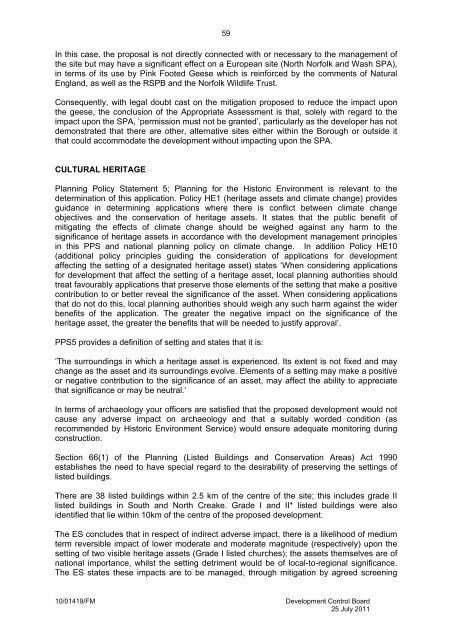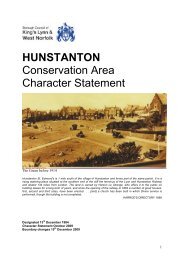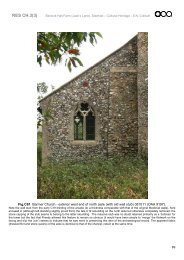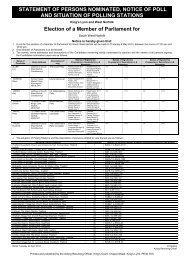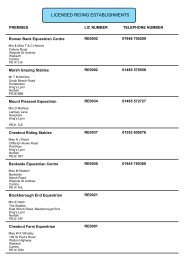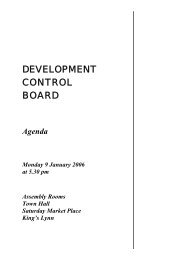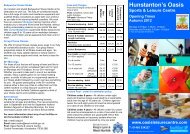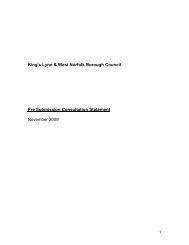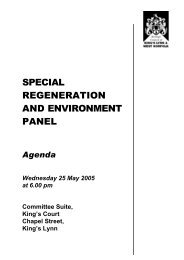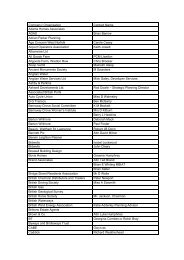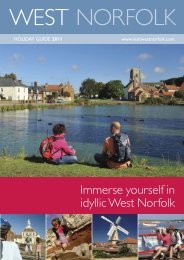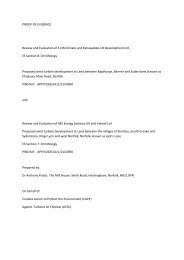11/00713/F - Borough Council of King's Lynn & West Norfolk
11/00713/F - Borough Council of King's Lynn & West Norfolk
11/00713/F - Borough Council of King's Lynn & West Norfolk
You also want an ePaper? Increase the reach of your titles
YUMPU automatically turns print PDFs into web optimized ePapers that Google loves.
In this case, the proposal is not directly connected with or necessary to the management <strong>of</strong><br />
the site but may have a significant effect on a European site (North <strong>Norfolk</strong> and Wash SPA),<br />
in terms <strong>of</strong> its use by Pink Footed Geese which is reinforced by the comments <strong>of</strong> Natural<br />
England, as well as the RSPB and the <strong>Norfolk</strong> Wildlife Trust.<br />
Consequently, with legal doubt cast on the mitigation proposed to reduce the impact upon<br />
the geese, the conclusion <strong>of</strong> the Appropriate Assessment is that, solely with regard to the<br />
impact upon the SPA, ‘permission must not be granted’, particularly as the developer has not<br />
demonstrated that there are other, alternative sites either within the <strong>Borough</strong> or outside it<br />
that could accommodate the development without impacting upon the SPA.<br />
CULTURAL HERITAGE<br />
Planning Policy Statement 5; Planning for the Historic Environment is relevant to the<br />
determination <strong>of</strong> this application. Policy HE1 (heritage assets and climate change) provides<br />
guidance in determining applications where there is conflict between climate change<br />
objectives and the conservation <strong>of</strong> heritage assets. It states that the public benefit <strong>of</strong><br />
mitigating the effects <strong>of</strong> climate change should be weighed against any harm to the<br />
significance <strong>of</strong> heritage assets in accordance with the development management principles<br />
in this PPS and national planning policy on climate change. In addition Policy HE10<br />
(additional policy principles guiding the consideration <strong>of</strong> applications for development<br />
affecting the setting <strong>of</strong> a designated heritage asset) states ‘When considering applications<br />
for development that affect the setting <strong>of</strong> a heritage asset, local planning authorities should<br />
treat favourably applications that preserve those elements <strong>of</strong> the setting that make a positive<br />
contribution to or better reveal the significance <strong>of</strong> the asset. When considering applications<br />
that do not do this, local planning authorities should weigh any such harm against the wider<br />
benefits <strong>of</strong> the application. The greater the negative impact on the significance <strong>of</strong> the<br />
heritage asset, the greater the benefits that will be needed to justify approval’.<br />
PPS5 provides a definition <strong>of</strong> setting and states that it is:<br />
‘The surroundings in which a heritage asset is experienced. Its extent is not fixed and may<br />
change as the asset and its surroundings evolve. Elements <strong>of</strong> a setting may make a positive<br />
or negative contribution to the significance <strong>of</strong> an asset, may affect the ability to appreciate<br />
that significance or may be neutral.’<br />
In terms <strong>of</strong> archaeology your <strong>of</strong>ficers are satisfied that the proposed development would not<br />
cause any adverse impact on archaeology and that a suitably worded condition (as<br />
recommended by Historic Environment Service) would ensure adequate monitoring during<br />
construction.<br />
Section 66(1) <strong>of</strong> the Planning (Listed Buildings and Conservation Areas) Act 1990<br />
establishes the need to have special regard to the desirability <strong>of</strong> preserving the settings <strong>of</strong><br />
listed buildings.<br />
There are 38 listed buildings within 2.5 km <strong>of</strong> the centre <strong>of</strong> the site; this includes grade II<br />
listed buildings in South and North Creake. Grade I and II* listed buildings were also<br />
identified that lie within 10km <strong>of</strong> the centre <strong>of</strong> the proposed development.<br />
The ES concludes that in respect <strong>of</strong> indirect adverse impact, there is a likelihood <strong>of</strong> medium<br />
term reversible impact <strong>of</strong> lower moderate and moderate magnitude (respectively) upon the<br />
setting <strong>of</strong> two visible heritage assets (Grade I listed churches); the assets themselves are <strong>of</strong><br />
national importance, whilst the setting detriment would be <strong>of</strong> local-to-regional significance.<br />
The ES states these impacts are to be managed, through mitigation by agreed screening<br />
10/01419/FM Development Control Board<br />
25 July 20<strong>11</strong><br />
59


